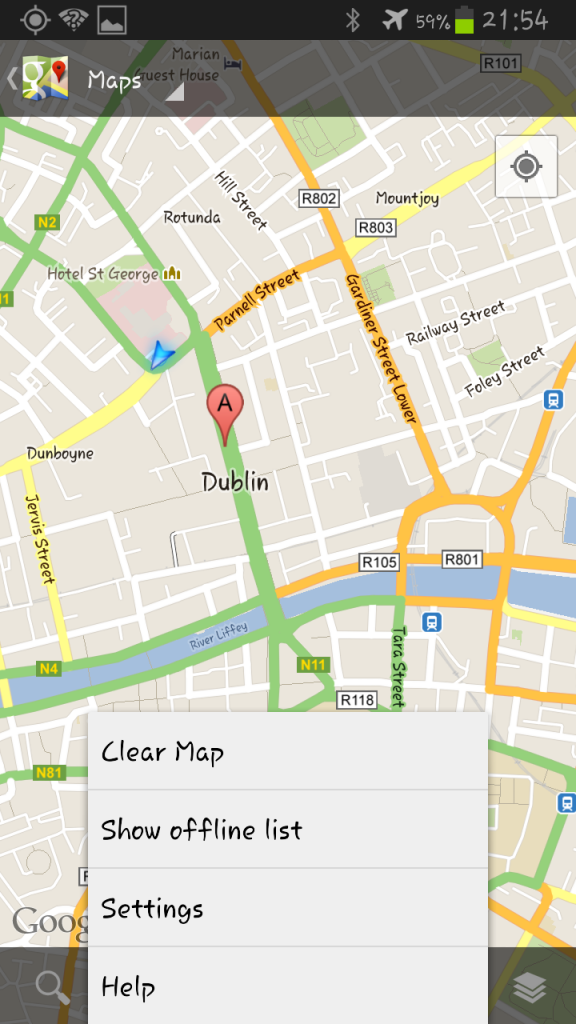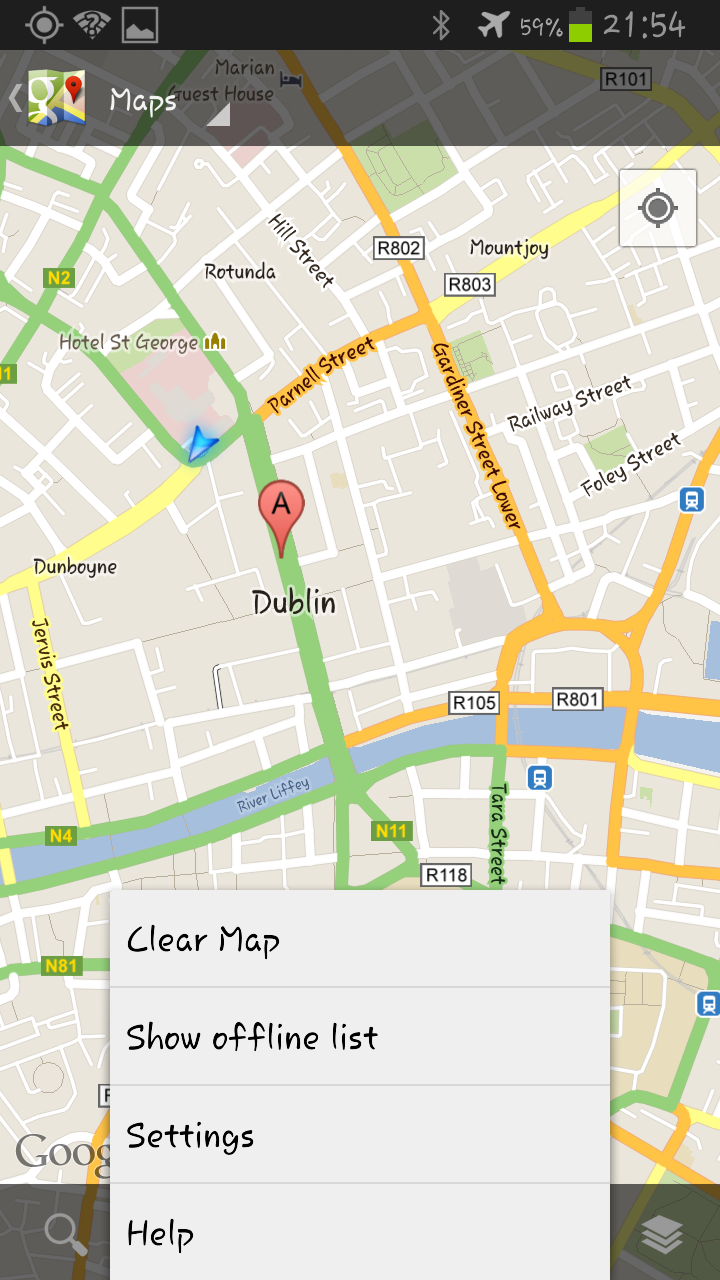
I Might Never Use A Paper Map Again
 In the middle of completing my month long work/vacation tour of Europe and Asia (as I sit on a plane on my way to Doha), I keep reflecting on the experience that has been these past couple weeks hopping around from London, to Amsterdam, to Switzerland and Ireland and never relying on a paper map.
In the middle of completing my month long work/vacation tour of Europe and Asia (as I sit on a plane on my way to Doha), I keep reflecting on the experience that has been these past couple weeks hopping around from London, to Amsterdam, to Switzerland and Ireland and never relying on a paper map.
I didn’t have data on my phone, but what I did have was the ability to download Google Maps to use offline. It is a feature that came to Android last June. After experiencing using the offline maps the past couple of weeks, I really think the paper map’s days are numbered.
Why my digital map beats your paper map
Constantly Updated:
Let’s start with the fact that the map that we had in our guide book was two years old. Two years, it seems, in Ireland is a long enough time for roads to be built as we found ourselves on roads that didn’t exist on the paper map we had.
Where Am I Now:
By far the most useful feature is the ability to know exactly where you are. GPS works all over the world and by turning on my GPS and loading the offline maps we knew exactly where we were on the bus, on the subway, on the running trail or on the street. We were able to plot our route with precision instead of “I think we’re somewhere around here.â€
Ability to explore and get lost with confidence:
What the GPS mentioned above allowed us to do was to explore with confidence. I was able to mark our B&B as a favorite on the map and then off we went. Walked around Amsterdam and when it was time to return home, pull out the map find where we were and plot a route home.
Ability to expand and zoom:
Your paper map can’t do this which is why you travel with a couple different ones. But on my phone the downloaded Google Map allowed me to zoom all the way in and all the way out to the point I downloaded the map from. Allowing me to see exactly where we were in the larger picture of the city.
Ease of carry and no folding:
Let’s face it, folding maps is never easy…..in fact I always used to see it as a traveling challenge that I had to solve. Now with the maps on my phone, nobody knows I’m a tourist. I just appear like everyone else looking at my phone and figuring out where to go next. I had the whole of Ireland in great detail in my pocket. Simply amazing.
Off the beaten path:
My wife and I wanted to go for a run in every country (mostly because we thought it would be cool to have it show up on our runkeeper timeline but also because we have a race coming up the beginning of April!). The Google Maps allowed us to find trails and details that were not possible on the tourist map we had. We were able to find running trails, to figure out our route and if we did get off track simply look it up on our phone. A great example was a trail we found that followed the subway line in Lausanne, Switzerland from our hotel down to the lake shore. We were thinking we would take the subway down to the lake, but after finding this hidden trail on the map we got an extra Km in on our run that we would not have known existed on the city map.
I could go on and on but I won’t. This is a game changer in all sorts of ways. Are we teaching students how to read a digital map? How to expand and zoom, how to orient the map to north vs the direction you’re walking and when to use both? Are we teaching the benefits of GPS, how to use it, how it works, and why it is a technology we all take for granted today but by itself is an amazing little feature built into almost every product?
This changes map skills, this changes what we need to be teaching students because the excuse of “what happens when you don’t have the Internet†just went out the window. With technology getting cheaper and cheaper, I wonder when a city might start distributing digital maps like this. Or what if you could check one out on a iPod touch from your hotel during your stay?
Game changer I tell you…..and one I’m not sure we’re preparing students for.







I would take it one step further: With projects like openstreetmap.org those who want can also learn to write maps, not just read them.
Where I live, OSM beats Google maps almost every time I go explore the back country. And when it doesn’t, I map my tracks to make it better for next time or the next person.
Totally agree! Can you take OSM offline with you when you travel and don’t have a data connection? If so might have to download that and give it a try.
There are many apps for Android that use OSM data. Some only stream the data, some download vector images for entire countries, while others download bitmap images for selected regions and zoom levels. I don’t know about iOS.
In fact, the reason I discovered OSM was that I needed offline maps back when google maps couldn’t be saved for offline use… Now, it’s the other advantages that have me use it more often than Google Maps.
And how about orienteering and/or geo-caching. Nobody here in BKK knows what geo-caching is. Is that dead, too?
No…I would say offline digital maps will only make geo-caching and other mapping games more popular. If I can download a map to my phone and not have to worry about data charges that’s an incentive.
I trashed my paper maps pretty much the second I bought a smart phone. In a classroom setting, at least from what I have seen, they’re not learning the new digital way of map reading nor how GPS works, at least, not where I live. This kind of technology does need to find its way into the classroom.
Being so confident with your smartphone makes me think that your device is nano-nuclear-powered. I also assume that your device is resistant/tough/durable enough not to break after a drop or two on a hard surface/rock. Even if so, just try to use your GPS enabled phone in a dense forest; you’ll be amazed to find out that the signal is so weak that your position will have up to 100 meters of error. I can’t imagine how useful might be if you’re still there after sunset. Oh, and when you’ll need details on your map to decide what route to take in order to get home safely, you’ll zoom in just to find out that the area on your screen is just to small to be useful. Happy dragging!
It is entirely up to you what gear you use for orienting and navigation, it is your choice and I respect that, but please don’t advise other people to do the same; they may put themselves in a dangerous situation.
By the way, the GPS is not working on the subway. If you were able to find your position there, that is because your device is able to use the signal of the gsm antennas, mounted in the subway tunnels, to get your position (which can have an error of up to several hundred meters).
100 meters? I’ll take that. Looking at a map and guessing….I would hope I would be within a 100 meters.
Dropping my phone yep…..tried reading a paper map in the rain once and one use and it was done. That doesn’t include mud puddles, wind or anything else that happens to break paper down.
After sunset? My phone map has a backlight so I can see it. Your paper map hope you packed the flashlight. Oh…and my map comes with a built in flashlight.
This blog is only my thoughts and opinions. I do not advise anyone to use any gear for any reason. I just reflect on my own learning and thinking.
GPS in the Subway? Hopefully I already know which way I want to go…and depends on the subway I guess. In Korea I had 4G the whole time I was on the train. Phone even updated me when my stop was the next one.
Not saying you have to use a phone/device….just saying maybe it becomes your main map and you keep that paper one for backup.
<> That depends on the map scale. If it is 1:500.000 then you’re right about guessing.
<> There are some map holders made out of transparent plastic that you can use with a paper map (and it’s cheaper than a smartphone protective sheet).
<> I mean walking at night with that 100 meters error (which my be in any direction). For reading the paper map one can use a small, key-chain type, led flashlight which is less prone to disrupt your natural night vision (in order to, let’s say, avoid breaking a leg).
<> That is entirely correct. I pointed that because of your own words <>. If I misunderstood the mean of “subway” then it’s my fault so please accept my apologize (it has several meanings and I took the one of underground train).
I am sure of your good intentions and that what you wrote represents your opinions. It’s only that some unaware people might take it as an “all you need” solution so I think it would be useful to show the both sides of the game. I used for some years both a smartphone and paper maps + compass and both proved to be useful. Either one have it’s own advantages and disadvantages, the question is what do you intend to use it for? In a city the GPS enabled phone is more useful, while in a remote place (where gps signal might be affected by environment or lack of electricity or you need some type of terrain details) a paper map (and I mean a topographic map not a Google one printed on A4 sheet) is by far the better choice.
No ofence, no arguing.